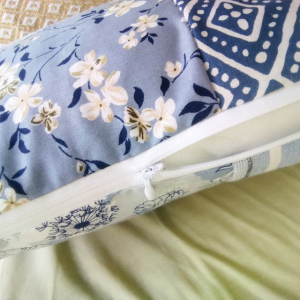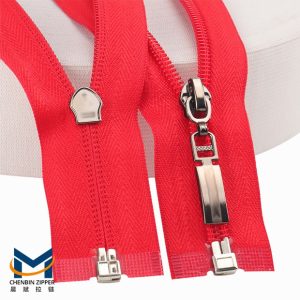Tracing the Origins of Polyester Zippers
Early Development and Manufacturing
Polyester zippers, what a time! Back in the mid-20th century, people were on the hunt for zippers that were both cheap and strong. They wanted something that could hold their pants up without breaking the bank. So, the brilliant minds of the time turned to Polyester. They thought, Hey, maybe this stuff could work! And boy, were they right. Polyester proved to be the perfect material for zippers. It could mold into these little teeth that were tough and flexible. It was like magic! Of course, back then, making these zippers was no easy task. It involved a lot of manual labor and integral tools. It was not exactly a high-tech operation. But they laid the groundwork for what was to come. And now, we have zippers galore because of those early pioneers.
Comparison with Other Materials
Compared to metal zippers, polyester zippers are notably lighter and more corrosion-resistant, making them well-suited for apparel and outdoor products. Unlike metal or natural fibers, polyester excels in strength, flexibility, and cost-effectiveness, making it a superior choice for various applications. The reduced cost and improved performance quickly garnered attention from kinds of industries, leading to a steady but slow adoption of polyester zippers.
Initial Applications and Popularity
Polyester zippers are in high-demand sectors like outdoor apparel, bags, and light industrial applications. Their ability to withstand many environmental conditions without degrading made them popular for tents, backpacks, and raincoats. Consumer goods manufacturers appreciated the balance of cost-effectiveness and durability that these zippers provided. Gradually, they expanded into the fashion and footwear industries, gaining widespread popularity due to their utility and aesthetic versatility.
Technological Advancements in Polyester Zippers
Improved Durability and Strength
Enhanced Fabric Integration Techniques
Innovations in textile engineering have vastly improved the way polyester zippers integrate with various fabrics. Advanced bonding techniques ensure the zipper remains securely attached to the garment or product, even under significant stress. Laser cutting and ultrasonic welding have replaced traditional sewing methods in many applications, providing cleaner lines and stronger bonds. These advancements prevent fraying and reduce wear, extending the life of the zipper and the item.
Resistance to Environmental Factors
The durability of Polyester has been enhanced through advancements in its formulation, enabling it to withstand UV radiation, moisture, and temperature fluctuations. This enhanced resilience makes polyester zippers ideal for use in outdoor and demanding environments. Advanced coatings and treatments enhance zipper durability and water resistance, enabling them to withstand extreme conditions. As a result, these zippers are now a preferred choice for outdoor gear, marine equipment, and protective clothing.
Innovations in Zipper Manufacturing
Automated Production Processes
With the advent of automation, the production of polyester zippers has seen significant advancements. Automated systems in modern factories handle every production process, from transforming polyester into shape to assembling the finished product. These processes not only speed up production but also enhance the precision and consistency of the zippers. Automation minimizes human error and increases the overall quality, making it possible to meet the growing global demand.
Quality Control Improvements
The focus on quality control has become more stringent over the years, marking a notable advancement in the manufacture of polyester zippers. Incorporating cutting-edge technology like computer-aided design (CAD) and computer-aided manufacturing (CAM) systems ensures each zipper meets high quality and performance standards. Real-time monitoring and advanced sensor systems allow manufacturers to detect and rectify defects quickly. This continuous quality assurance results in more reliable and long-lasting zippers, benefiting consumers and manufacturers alike.
In summary, the evolution of polyester zippers reflects a comprehensive transformation from their early, manually-intensive beginnings to today’s high-tech, automated production processes. Each innovation and improvement has made these zippers an integral component in different industries, showcasing their indispensable role in modern textile and fashion technology.
Design and Functional Innovations
Diverse Color and Pattern Options
The broad acceptance and technological progress in the manufacturing of polyester zippers have facilitated a significant variety in color and pattern choices. Advanced dyeing and printing methods have evolved, providing a spectrum that spans from classic hues to lively, multi-colored patterns. This adaptability allows designers to align zippers accurately with different fabrics, boosting the visual appeal of products. Personalized patterns, such as logos and unique designs, can also be integrated, making polyester zippers not merely functional components but essential aspects of the overall design narrative. This in part laid the foundation for the development of custom zippers.
Customization Capabilities
The demand for personalized products has never been higher in the current market. Polyester zippers offer significant customization capabilities, from specific color matching to unique zipper pulls. Customers can request tailored solutions that align with their brand identity or personal preferences. This level of customization extends to features such as waterproofing, reflective elements, and even antimicrobial treatments. The ability to customize zippers to such a high degree adds value and uniqueness to the products they are used in, making them highly desirable in both fashion and functional applications.
Specialized Variants for Different Industries
Polyester zippers are not a one-size-fits-all solution. They have been specialized to meet the distinct needs of various industries, each requiring different attributes from their fastening systems.
Apparel Industry Needs
The apparel industry has a diverse range of garments, from haute couture to sportswear, which relies on polyester zippers for their versatility and durability. Fashion designers favor these zippers for their lightweight nature and the myriad of design options available. For sportswear, the requirement is more technical—zippers must be durable, lightweight, and able to function smoothly without adding bulk. Moreover, their easy maintenance and resistance to wear and tear make them ideal for everyday clothing.
Outdoor Gear and Luggage Requirements
Outdoor gear and luggage require zippers that withstand harsh conditions and frequent use. Polyester zippers excel in these environments due to their strength and resistance to UV light, water, and extreme temperatures. Reinforced polyester zippers are essential for items like backpacks, tents, and heavy-duty luggage because they ensure these products can withstand extended exposure to the elements and rigorous handling. Accordingly, we can call these products heavy-duty zippers. Additionally, advancements such as self-repairing zippers are increasingly being integrated into outdoor gear, providing an added level of dependability and longevity..
Trends Shaping the Future of Polyester Zippers
Sustainability Efforts
As the global emphasis on sustainability grows, polyester zippers are evolving to meet these new demands. The industry is witnessing significant shifts towards more environmentally conscious manufacturing practices.
Use of Recycled Materials
The production of polyester zippers is progressively incorporating recycled materials to minimize environmental impact. Manufacturers utilize recycled polyester derived from post-consumer plastic bottles and other recycled content. This practice reduces waste and lessens dependence on virgin polyester, promoting a circular economy. The result is zippers that offer the same durability and aesthetic appeal as their non-recycled counterparts while contributing to environmental sustainability.
Eco-Friendly Production Practices
Beyond using recycled materials, the production processes for polyester zippers are becoming more eco-friendly. Advancements in technology have enabled manufacturers to reduce energy consumption and emissions during production. Waterless dyeing methods and non-toxic dyes are adopted to reduce water pollution, while energy-efficient automation lowers the industry’s carbon footprint, promoting overall sustainability.
Smart Zipper Technologies
Innovate technologies are revolutionizing polyester zippers, turning them into intelligent elements that boost the usability of the same objects.
Integration with Wearable Tech
Polyester zippers are evolving into intelligent wearable, incorporating sensors for tracking physical activity and health data. These innovative zippers blend seamlessly with fashion and technology, offering traditional fastening and advanced functionalities. This innovation is especially beneficial for sportswear and medical garments that require real-time data monitoring.
RFID-Enabled Zippers for Tracking
Radio Frequency Identification (RFID) technology is another area where polyester zippers are seeing significant innovation. RFID-enabled zippers can be used for tracking and inventory management, providing a unique identifier for each product. It is helpful in logistics, retail, and even the military, where efficient tracking and managing vast quantities of items is essential. These intelligent zippers can streamline supply chains, enhance security, and improve inventory accuracy, showcasing their expanding role in modern industries.
In summary, the continuous evolution of polyester zippers demonstrates their adaptability and growing relevance in various sectors. Zippers are at the forefront of innovation, combining enhanced functionality, improved aesthetics, and alignment with sustainability and technological trends.
The Impact of Market Demands and Consumer Preferences
Influence of Fashion Trends on Zipper Design
The ever-evolving landscape of fashion trends significantly influences the design and functionality of polyester zippers. Seasonal shifts and the latest runway styles create new requirements regarding colors, patterns, and designs. Designers seek zippers that not only function effectively but also enhance the overall aesthetic of their garments. It has spurred the creation of zippers with innovative finishes, including metallic shades, matte textures, and reflective surfaces. Furthermore, there is an increasing preference for invisible zippers that integrate seamlessly with fabrics, offering a sleek and polished appearance. These trendsetting designs ensure that polyester zippers remain essential and relevant in modern clothing.
Growth in E-commerce and Its Effect on Product Development
The surge in e-commerce has significantly influenced the development and distribution of polyester zippers. Online shopping platforms have expanded consumer choice and accessibility, requiring manufacturers to cater to a more diverse market. Rapidly changing consumer preferences and the need for quick turnover inventory necessitate efficient production processes. As a result, manufacturers have invested in advanced logistics and faster production cycles to meet the demands of the online retail environment. Furthermore, the global reach of e-commerce has highlighted the importance of high-quality, durable zippers that can withstand the rigors of shipping and handling, ensuring customer satisfaction and reducing return rates.
Conclusion: The Ongoing Journey of Polyester Zippers
The evolution of polyester zippers is a testament to the continuous innovation and adaptability within the textile and fashion industries. From their origins in the mid-20th century as cost-effective and durable alternatives to metal and natural fibers, polyester zippers have undergone significant transformations. Technological advancements have enhanced their durability, environmental resistance, and integration with various fabrics. Furthermore, the diversification of design options and customization capabilities has made them indispensable in fashion and functional applications.
Innovation in manufacturing processes, including automation and stringent quality control, has ensured that polyester zippers meet the highest standards of precision and reliability. Trends toward sustainability and the development of intelligent technologies indicate a forward-looking industry responsive to global concerns and consumer demands. The recycled materials and eco-friendly production practices reflect a commitment to environmental stewardship. Zippers are increasingly becoming integral to modern life, as evidenced by the combination of RFID technology and wearable tech applications..












